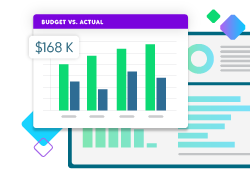Good, Better, Best: How to Become a Tech-Powered Nonprofit

Nonprofits operate on trust.
To thrive in today’s philanthropic environment, nonprofits must demonstrate to donors and community stakeholders that their dollars are being put to good use. Nonprofits must earn their trust.
Meeting such high expectations for transparency and ROI requires a lot of time and resources from staff, but the right technology can help your organization operate more efficiently and responsibly, allowing you to focus on your mission and grow your impact.
Nonprofit organizations need to leverage the full capabilities of modern fundraising and fund accounting software in order to create an environment of sustainable stewardship and meet the expectations of their donors and the communities they serve.
For a recent webinar, Blackbaud experts invited panelists from nonprofit consulting firm Cause and Solution, Inc. and Ronald McDonald House Charities of Oregon and Southwest Washington to discuss how nonprofit organizations can best leverage new technologies.
How the Role of Technology has Evolved for Nonprofits
People who have worked in nonprofits for many years will recall a time—not all that long ago—when much of the work of development and finance was done on paper and stored in rows and rows of filing cabinets. Today cloud-based software has replaced much more than printed donor lists and fundraising reports.
Here are the five tech-driven improvements that are here to stay for nonprofits:
1. Intuitive Dashboards
Business intelligence dashboards provide an easy access point for all kinds of data. These dashboards make data easy to understand and are intuitive to use, even for people who may not have a data or analytics background. Clear and easy to understand data empowers members of the entire organization with tools to improve their jobs.
2. Connected Systems
Integrated platforms that communicate with one another replace disparate systems for development, accounting, online donations, and even email communications. An integrated system not only eliminates the manual processes and cumbersome workarounds, but it can also provide valuable information where it’s most needed, such as displaying a donor’s email engagement stats alongside giving activity.
3. Automated Processes and Internal Controls
Key information and processes are immortalized within technological systems, providing stability to organizations in the case of staff turnover, reorganizations, or other disruptions. With processes such as data validation or error-checking built into the technology, your staff can focus on value-add activities and strategic initiatives.
4. Real-Time Data
Access to real-time data allows organizations to be proactive, rather than reacting to 30- or 60-day-old data reports to make critical business decisions. Up-to-date information and broader data access also increase the chances of catching mistakes or anomalies before they can wreak havoc.
5. View-Only Access to Information
Tools for frontline fundraisers not only put data into the hands of the people who can use it to raise money for your organization, but also allow development staff to update donor records and perform other key tasks without adding to the CRM administrator’s workload.
How to Improve Your Nonprofit Technology from Good to Better to Best
Once your organization begins to embrace technology as a tool for efficiency and sustainable stewardship, it’s still important to recognize where you stand on the continuum of making full use of your technological resources.
After all, implementing even the most sophisticated fundraising or fund accounting software will have little positive impact if your organization uses only a fraction of its capabilities—or worse, if you’ve tried to cram old processes into a new system.
Here are some helpful ways to think of your organization’s technological evolution as it applies to development, finance, and the entire organization.
Good: Seeing Early Improvements from Technology
As you begin to onboard new software solutions, the first level of improvement to look for within your fundraising database is basic data health. All your records should be accurate, complete, and up to date, and your new system should align with the way your organization handles campaigns, funds, and appeals.
When it comes to fund accounting software, many organizations begin by simply tracking balances within individual funds and maintaining the separation of restricted monies for compliance purposes. Your fund accounting system is capable of doing much more, but this is a good starting point that is also a significant step up from using spreadsheets.
At the “good” level, the impact on your organization will still be significant. You’re beginning to remove some manual processes and call on technology to drive efficiency, freeing up staff to focus on organizational priorities.
Better: Putting Tech to Work for You
The next step in leveraging technology for your organization might look like elevating how you use your fundraising database. Instead of treating it as a static repository for donor information, use it as a system to support fundraising efforts, taking full advantage of built-in tools like wealth ratings to identify top prospects and understand their capacity to give.
If separate arms of your organization target the same donors—such as different departments within a university, for example—your integrated system will help you present yourself in a cohesive and professional manner.
At this level, your fundraising and finance systems begin working together in a hybrid approach. Perhaps accounts payable and other processes still happen within a parent system, but you have information actively flowing from development to finance in order to keep your fund accounting up to date.
All of this helps provide accountability and transparency to your donor base, building trust with your most important stakeholders.
Best: Becoming Truly Tech-Powered
The ultimate goal is not just to have all your technology working in sync, but for your systems to inform the way your people work together, too.
When your fundraising system integrates seamlessly with your fund accounting software, your development and financial teams can work more cohesively too, using a shared language to better understand what’s happening in both areas of the organization.
As you depend on and come to use your fund accounting software as your organization’s book of record, you can employ the system’s data to streamline and simplify the audit process. You can make data-driven decisions with confidence, knowing that you have access to the most up-to-date and reconciled information.
Becoming a tech-powered nonprofit allows your organization to demonstrate high accountability and meaningful stewardship in more efficient ways, making the most of your resources while building trust with your stakeholders. Your systems will be doing the system work, and your people will be available to do the people work.
Fund Accounting Software that Drives Impact
Find out how Blackbaud’s Financial Edge NXT® fits your organization.

Making the Change: How to Ease the Transition
To evolve into a tech-powered nonprofit, the first step is to take a close look at what systems, processes, and technology are currently working—and not working—for your organization. Only with these answers will you be able to understand where you need to make changes.
Wherever you are in adopting new technologies, you must be willing to have these conversations. They can be difficult, especially when people are used to doing things in a particular way or if the organization is siloed to the extent that these cross-functional discussions have never happened before. And conversations about what is and isn’t working are still important at your organization’s “best” level as your needs and systems will continue to evolve as the organization grows.
Once you have decided to make a change, prioritize getting buy-in from leadership and from the people who will be working in the new systems. Change resistance comes from people accustomed to current processes who are hesitant to encounter the unknown that lies between where you are and where you are going. Make sure leaders understand the benefits of change and bring trusted partners such as consultants alongside you for support.
One of the best ways to combat change resistance is to show value quickly. The more early wins you achieve and the more clearly people can see how the new system will help them do their jobs, the less threatening the changes appear.
Try starting with some simple dashboards or automation that remove manual processes. Both quick wins will help build confidence and trust in the systems.
Build Trust Through Accuracy and Transparency
Investing in tech-powered efficiencies is ultimately an investment in the people who work for your organization, as well as your donors, volunteers, and the community you serve. Harnessing the power of software solutions for fundraising and fund accounting leads to more transparency and accountability, which builds the trust you need to keep doing good mission-driven work.
For more specifics on how to use Blackbaud Financial Edge NXT® and Blackbaud Raiser’s Edge NXT® to accelerate your technological transformation, check out the on-demand product tour.


